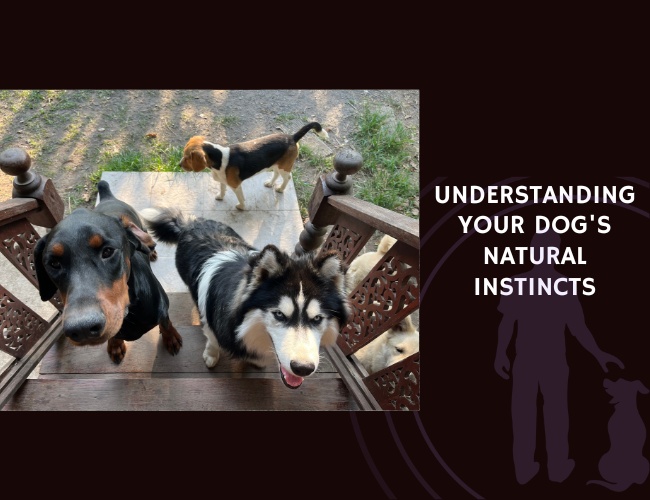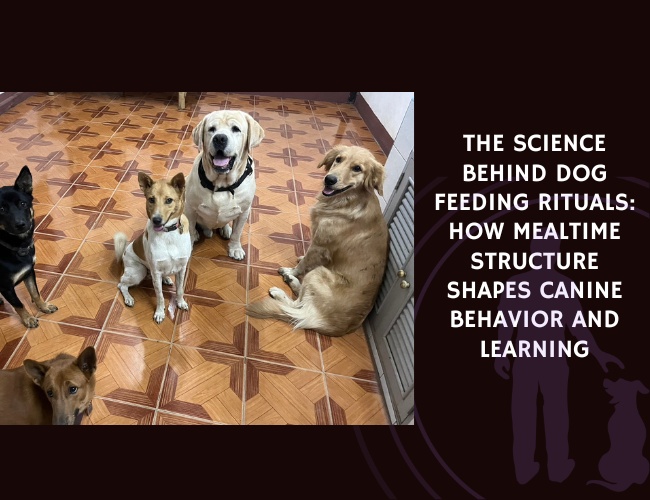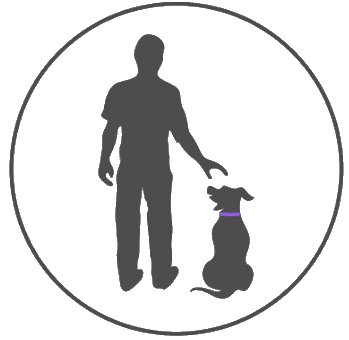Introduction to Canine Instincts
Evolution from Wolves and Retained Instinctual Behaviors
Dogs, or Canis lupus familiaris, evolved from wolves approximately 15,000 years ago. During this time, humans and wolves developed a symbiotic relationship, leading wolves to gradually evolve into the domestic dogs we know today. This evolution involved adapting behaviors that benefited their new roles in human societies, while still retaining many instinctual behaviors from their wild ancestors.
Wolves are intelligent, social creatures with highly structured pack dynamics and intricate hunting strategies. Modern dogs have inherited these traits, although they manifest differently compared to their wild forebears. Understanding these retained instincts helps us better comprehend our dogs’ natural behaviors and needs in today’s domestic setting.
The Role of Selective Breeding in Enhancing Specific Instincts
Selective breeding has played a significant role in shaping the behaviors and characteristics of different dog breeds. Over centuries, humans have bred dogs for specific purposes, enhancing particular instincts to create breeds best suited for tasks like herding, hunting, guarding, and companionship.
For instance, herding breeds like Border Collies have been bred to accentuate their natural herding instincts, making them adept at managing livestock. Similarly, Retrievers were selectively bred to dutifully retrieve game without damaging it, highlighting their gentle mouths and eagerness to please. This selective breeding has reinforced certain behaviors, making it essential for owners to understand the inherent traits of their dog’s specific breed.
Importance of Understanding Natural Instincts in Modern Dogs
Recognizing and understanding your dog’s natural instincts is crucial for fostering a harmonious relationship and providing the best care possible. Natural instincts drive many of your dog’s behaviors, and by acknowledging these drives, you can better address their needs and ensure their well-being.
For example, a dog exhibiting herding behavior might try to herd children or other pets. Understanding this as an inherited trait rather than problematic behavior allows you to address it appropriately by providing the dog with suitable outlets for their instincts, such as interactive herding games or puzzle toys.
Moreover, understanding natural instincts aids in training efforts. Knowing what motivates your dog can make training more effective and enjoyable for both you and your pet. It also helps in creating an environment that supports your dog’s natural behaviors, reducing stress and promoting a happier, healthier life.
By acknowledging these inherited instincts, you not only improve your dog’s life but also strengthen your bond with them. It’s about recognizing that while our dogs may live in our modern world, their behaviors and needs are deeply rooted in their ancestral past, and respecting this connection leads to more effective and compassionate pet ownership.
Herding Instincts and Behaviors
Herding instincts are among the most recognizable natural behaviors in certain dog breeds. Initially bred to help manage livestock, herding dogs possess an array of unique tendencies. Let’s delve deeper into the characteristics of herding breeds, how their instincts manifest in domestic environments, and highlight some common herding breeds along with their specific traits.
Characteristics of Herding Breeds and Their Natural Tendencies
Herding breeds are known for their energetic and intelligent nature. Typically, these dogs exhibit a strong work ethic and a keen instinct to control the movement of other animals. Common traits include:
- High Energy Levels: Herding dogs have abundant energy that needs regular outlets.
- Intelligence: These breeds are highly intelligent and quick learners, making them adept at picking up commands and tasks.
- Focus and Drive: An unwavering focus on their “job” whether it’s herding animals or performing tasks.
- Alertness: Naturally vigilant, herding dogs are often very aware of their surroundings.
- Protectiveness: Protective instincts, especially when it comes to the safety of their “flock” (whether that’s other animals or family members).
How Herding Behaviors Manifest in Domestic Settings
When herding breeds find themselves in domestic settings without livestock to manage, their instincts can often translate to various behaviors. Owners sometimes observe their herding dogs displaying these tendencies with children, other pets, or even inanimate objects. Common manifestations include:
- Nipping and Nudging: Herding dogs may gently nip at heels or nudge people and animals to guide their movement, simulating the herding behavior used to manage livestock.
- Circling: These dogs might run in circles around their family members or other animals, mimicking the way they would round up a flock.
- Barking: Frequent barking to control movement and alert their owners, sometimes without an obvious reason.
- Chasing: A strong instinct to chase moving objects such as cars, bikes, and other animals.
It’s crucial for owners to provide equal parts physical and mental stimulation to help manage these instincts in a positive and constructive manner.
Common Herding Breeds and Their Specific Traits
Several breeds are renowned for their herding abilities, each with distinctive characteristics and qualities. Here is a look at some common herding dogs:
- Border Collie: Known for intense focus and boundless energy, Border Collies are often touted as the most intelligent dog breed. They excel in obedience, agility, and, of course, herding livestock.
- Australian Shepherd: Nicknamed ‘Aussies,’ these dogs are highly intelligent and versatile, often seen participating in various dog sports. Australian Shepherds are enthusiastic, loving, and known for their distinctive merle coats.
- German Shepherd: While now famous for roles in protection and law enforcement, German Shepherds’ herding roots are still evident. They are intensely loyal, trainable, and embody a strong protective instinct.
- Shetland Sheepdog: Affectionately known as ‘Shelties,’ these small but agile dogs pack a big punch when it comes to intelligence and energy. Their ability to herd sheep on rugged terrain stems from their Scottish origins.
- Corgi (Pembroke Welsh and Cardigan): Though small, Corgis are robust, with an innate ability to nip at the heels of cattle. Their low height lets them avoid kicks from livestock. They are energetic, friendly, and alert watchdogs.
Recognizing that herding instincts are deeply ingrained in these breeds is vital for owners. Providing activities that mimic their natural work, such as agility training or obedience courses, helps satisfy these instincts and creates a happy, well-balanced pet.
Understanding these breeds’ characteristics and behaviors can enhance our interactions with them, ensuring they remain both happy and well-adjusted in our homes.
Next, we’ll explore how the hunting instincts of modern dogs come into play in their daily lives.
Hunting Instincts in Modern Dogs
As we delve into the fascinating world of canine instincts, it’s important to understand the strong hunting instincts present in many modern dogs. Historically utilized for survival, these behaviors have been shaped and intensified by selective breeding, resulting in dogs with specific hunting skills that manifest in various ways today.
Different Types of Hunting Behaviors
Hunting behaviors in dogs can be broadly categorized into tracking, retrieving, and pointing. Each of these behaviors is distinct and has been fine-tuned over generations to serve particular purposes in hunting activities.
Tracking
Tracking is the ability to follow a scent trail left by prey. This skill is highly developed in breeds like Bloodhounds and Beagles, whose keen sense of smell allows them to follow a trail for miles. In domestic settings, tracking behavior might be seen when a dog sniffs around persistently, trying to locate a toy or treat that has been hidden.
- Bloodhounds: Known for their unparalleled scenting ability, these dogs are often used in search and rescue missions.
- Beagles: Small yet energetic, Beagles are excellent at following scent trails, making them popular for hunting small game.
Retrieving
Retrieving involves bringing back hunted prey to the owner. This instinct is most prominent in breeds like Retrievers (as the name suggests) and Spaniels. In a home environment, this behavior is often displayed through fetching games, where the dog eagerly retrieves a ball or stick.
- Labrador Retrievers: Renowned for their love of water and retrieving ability, they are commonly used in waterfowl hunting.
- Golden Retrievers: Known for their gentle mouths, they are excellent at retrieving game without damaging it.
Pointing
Pointing is the act of signaling the presence of prey by freezing and directing attention toward it, typically with an outstretched paw. Breeds like Pointers and Setters have this instinct highly developed. At home, a dog might display pointing behavior by intently staring or freezing when they sense the presence of something interesting, such as a bird outside the window.
- English Pointers: Their keen sense of smell and natural stance make them ideal for pointing out game birds.
- Irish Setters: Elegant and energetic, these dogs are known for their impressive pointing ability during hunts.
Manifestation of Hunting Instincts in Everyday Activities
Even without an outlet for traditional hunting, these instincts find ways to surface in everyday activities. Dogs might show these behaviors during play, walks, or when interacting with their surroundings.
- Tracking: Nose-to-the-ground behavior on walks or when exploring new environments.
- Retrieving: Enjoying games of fetch or bringing back toys unprompted.
- Pointing: Freezing or focusing intently on small animals, objects, or even shadows.
Understanding these manifestations can help owners provide appropriate outlets for their dogs’ natural behaviors, minimizing frustration and promoting well-being.
Breed-Specific Hunting Traits and Characteristics
Breed-specific traits are a vital aspect of understanding a dog’s hunting instincts. Each breed brings its unique set of skills, shaped by history and purpose. Recognizing these traits can guide owners in offering suitable activities and training.
- Retrievers (Labrador and Golden): Social and enthusiastic, these breeds thrive on interactive play that engages their retrieving instincts.
- Scent Hounds (Bloodhound, Beagle): Providing scent-based games or trials can satisfy their strong urge to track.
- Pointers and Setters (English Pointer, Irish Setter): Incorporating games that mimic hunting scenarios, such as “find the toy,” can channel their pointing behaviors.
Embracing these natural instincts through tailored activities ensures a happier, more fulfilled dog. Next, we will explore the intricate social behaviors and pack mentality that play a significant role in canine interactions and relationships with humans. This understanding will further aid in creating harmonious and well-adjusted pets.

Social Behaviors and Pack Mentality
Dogs, much like their ancestors, are inherently social creatures. Understanding their social behaviors and pack mentality is crucial for building strong relationships with our canine companions and ensuring their well-being.
Understanding Pack Hierarchy and Social Structure
Dogs are descendants of wolves, and though domesticated, they have retained some of their ancestors’ social structures. In a pack, wolves establish a hierarchy that dictates each member’s role and responsibilities. Similarly, your dog views its family as its pack and will often look for its place within this social structure.
- Alpha Position: The alpha is the leader of the pack. In a domestic setting, you or other family members should assume this role to maintain order.
- Subordinate Roles: Dogs within a pack also recognize subordinate positions, which can help avoid conflicts and promote cooperation.
- Role Establishment: Dogs will test boundaries and display behaviors to ascertain their position within the pack. Consistent training and clear rules are essential for establishing your leadership.
Recognizing and understanding these hierarchical behaviors can help you manage and guide your dog more effectively.
How Social Instincts Influence Interactions with Humans and Other Pets
Your dog’s social instincts play a significant role in their interactions with you and other pets. Here are some common behaviors and their underlying instincts:
- Gregarious Nature: Dogs have a natural tendency to seek companionship and form bonds. This is evident when they follow you around the house or become attached to other pets.
- Protective Behavior: Instincts to protect and defend the pack can translate into protective behaviors towards family members and territory.
- Affection Seeking: Dogs often seek physical closeness, such as snuggling or leaning, to reinforce bonds and express affection.
- Playfulness and Social Play: Play is not merely a pastime for dogs; it’s a way to establish social bonds, practice survival skills, and communicate.
It is important to recognize these behaviors as instinctual and understand that they are a fundamental part of your dog’s social nature.
The Importance of Socialization in Managing Instinctual Behaviors
Socialization is crucial in helping your dog navigate the complexities of their instinctual behaviors and interactions with the human world. Proper socialization involves exposing your dog to various stimuli and experiences to ensure they grow into well-adjusted adults.
- Early Exposure: Introducing your puppy to different environments, people, and animals at a young age is beneficial.
- Positive Reinforcement: Rewarding your dog for calm and appropriate behaviors during social interactions helps reinforce positive experiences.
- Gradual Introduction: Gradually increasing the complexity of social situations can help prevent overwhelming your dog and promote positive associations.
By prioritizing socialization, you can help your dog develop the confidence and skills needed to manage their natural behaviors in a way that is harmonious with modern living.
Understanding and respecting your dog’s social behaviors and pack mentality is essential for fostering a healthy and fulfilling relationship. As you navigate the journey of managing your dog’s instinctual behaviors at home, know that creating a home environment that recognizes and nurtures these instincts can lead to a happier and more balanced life for your furry friend.
Managing Instinctual Behaviors at Home
Positive Channeling of Natural Instincts through Appropriate Activities

As we’ve learned, dogs come with a bundle of natural instincts derived from their wild ancestors. Managing these behaviors at home often involves providing opportunities for dogs to express themselves in ways that align with their inherent tendencies. This not only keeps your furry friend happy but also helps prevent unwanted behaviors.
For herding breeds, channel their energy with activities that mimic herding. Agility courses, obedience training, and interactive toys can provide mental stimulation and physical exercise. For hunting breeds, consider activities like scent tracking games, fetch, or hide-and-seek to satisfy their instinctual drive. Engaging in activities directly related to these instincts can heavily minimize misbehaviors at home and provide much-needed mental challenges.
Other practical ways to positively channel a dog’s natural instincts include:
- Enrichment Toys: Use puzzle feeders and treat-dispensing toys to challenge your dog’s problem-solving skills.
- Structured Play: Engage in regular games of fetch, tug-of-war, or frisbee to provide physical outlets.
- Training Exercises: Use training sessions to strengthen obedience and focus, providing both mental and physical engagements.
Addressing Problematic Behaviors Stemming From Instincts
While it’s natural for dogs to exhibit certain behaviors, some actions can be problematic in a domestic setting. Understanding why your dog behaves in a certain way is the first step in addressing these issues humanely and effectively.
For instance, herding breeds might nip or chase small children or other pets. Hunting breeds may dig up the yard or constantly bark at small animals. Recognizing these behaviors as a manifestation of their instincts allows for a compassionate response rather than punishment.
Three effective strategies include:
- Redirection: When an undesirable behavior emerges, redirect your dog’s attention to a more appropriate activity.
- Positive Reinforcement: Reward your dog with treats, praise, or play when they display desired behaviors.
- Consistency: Be consistent with commands and routines to reinforce learning and good behavior.
Addressing these instinctual behaviors without punishment ensures your dog remains confident and trusting.
Creating an Environment That Accommodates Natural Behaviors
Creating an environment that accommodates a dog’s natural behaviors is crucial for any dog owner. Dogs thrive in settings where they can safely and freely express themselves. Providing a balance between freedom and structure is key.
- Safe Spaces: Ensure your dog has access to spaces where they can safely explore and play, such as a fenced yard or a designated play area inside the home.
- Comfortable Rest Areas: Provide cozy, quiet spaces where your dog can retreat and relax, acknowledging their need for regular downtime.
- Stimulation Zones: Set up areas with interactive toys, chew toys, and climbing or hiding spots to keep your dog entertained and mentally stimulated.
By accommodating your dog’s natural behaviors, you create a harmonious living environment. Understanding and embracing your dog’s instincts can lead to a more fulfilling relationship between you and your canine companion, fostering trust and happiness.
Training Strategies and Solutions
Now that we’ve explored the importance of managing your dog’s instinctual behaviors at home, it’s time to discuss strategies and solutions for training. Tailored training is essential to help your dog thrive while respecting their natural instincts.
Breed-Specific Training Approaches
Different breeds have unique instincts that influence their behavior, and understanding these can help in providing effective training. By respecting these innate traits, training can be more enjoyable and productive both for you and your furry friend.
Herding Breeds
Herding dogs such as Border Collies and Australian Shepherds are known for their intelligence and high energy levels. Their natural tendency to herd can sometimes be seen in behaviors like nipping at heels or circling around people and other animals. To channel these instincts positively, consider:
- Agility Training: Setting up agility courses can provide physical exercise and mental stimulation.
- Obedience Training: These breeds thrive on learning and following commands. Regular obedience training sessions can help them stay focused.
- Interactive Toys: Toys that require problem-solving or mental engagement can keep their sharp minds occupied.
Hunting Breeds
Breeds with strong hunting instincts, such as Retrievers and Beagles, often show behaviors related to their hunting roles. Understanding these can help in training:
- Scent Games: Engage their sense of smell with scent tracking games. Hide treats for them to find or use scent dispensers to create a trail.
- Retrieving Activities: Reinforce natural retrieving behaviors with fetch games using balls or dummies.
- Controlled Play: Use structured playtime to manage their energy, preventing them from becoming overly excited or destructive.
Social Breeds
Dogs with strong social instincts, like Labrador Retrievers and Golden Retrievers, benefit from training that enhances their sociable nature:
- Group Playdates: Organize supervised play sessions with other dogs for social interaction.
- Consistent Routine: Establish a routine that helps them understand expectations and reduces anxiety.
- Positive Reinforcement: Reward good behavior immediately. Positive reinforcement strengthens their bond with you and encourages repeat behavior.
Techniques for Redirecting Unwanted Instinctual Behaviors
Even the most well-behaved dogs can exhibit unwanted behaviors influenced by their instincts. Redirecting these behaviors requires patience and consistency.
Excessive Barking
Common in herding breeds, barking can be controlled by:
- Command Training: Teach commands such as “quiet” or “enough” and reward compliance.
- Distraction: Engage with a toy or activity at the first sign of barking to divert their attention.
Chewing
Chewing, especially in hunting breeds, can be curbed by:
- Appropriate Chew Toys: Provide plenty of appropriate objects for them to chew on, reducing the likelihood they’ll target household items.
- Exercise: Ensure they receive sufficient physical and mental stimulation to prevent boredom-driven chewing.
Establishing Boundaries While Respecting Natural Instincts
Setting boundaries is critical for a harmonious household, but these should be reasonable and respectful of your dog’s instincts.
Defining “Off-Limits” Areas
Using gates or barriers to keep certain areas of the home off-limits can help maintain order. Consistency in enforcing these boundaries is key.
Consistent Rules
Make sure all family members are on the same page regarding the rules. Inconsistencies can confuse your dog and undermine training efforts.
By understanding and respecting your dog’s natural instincts, you can develop training methods that work harmoniously for both of you. Set clear boundaries and use instinct-friendly training techniques.









